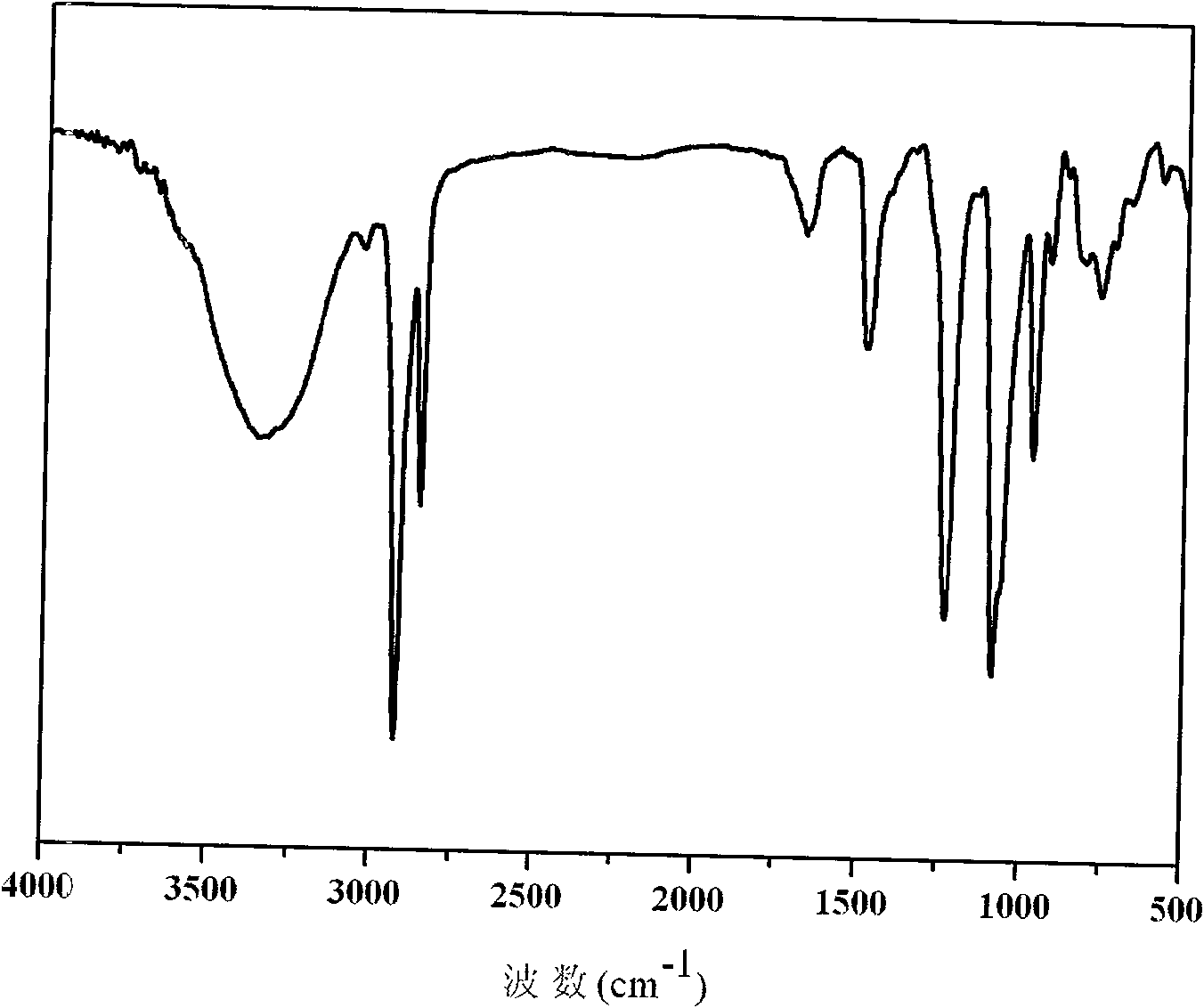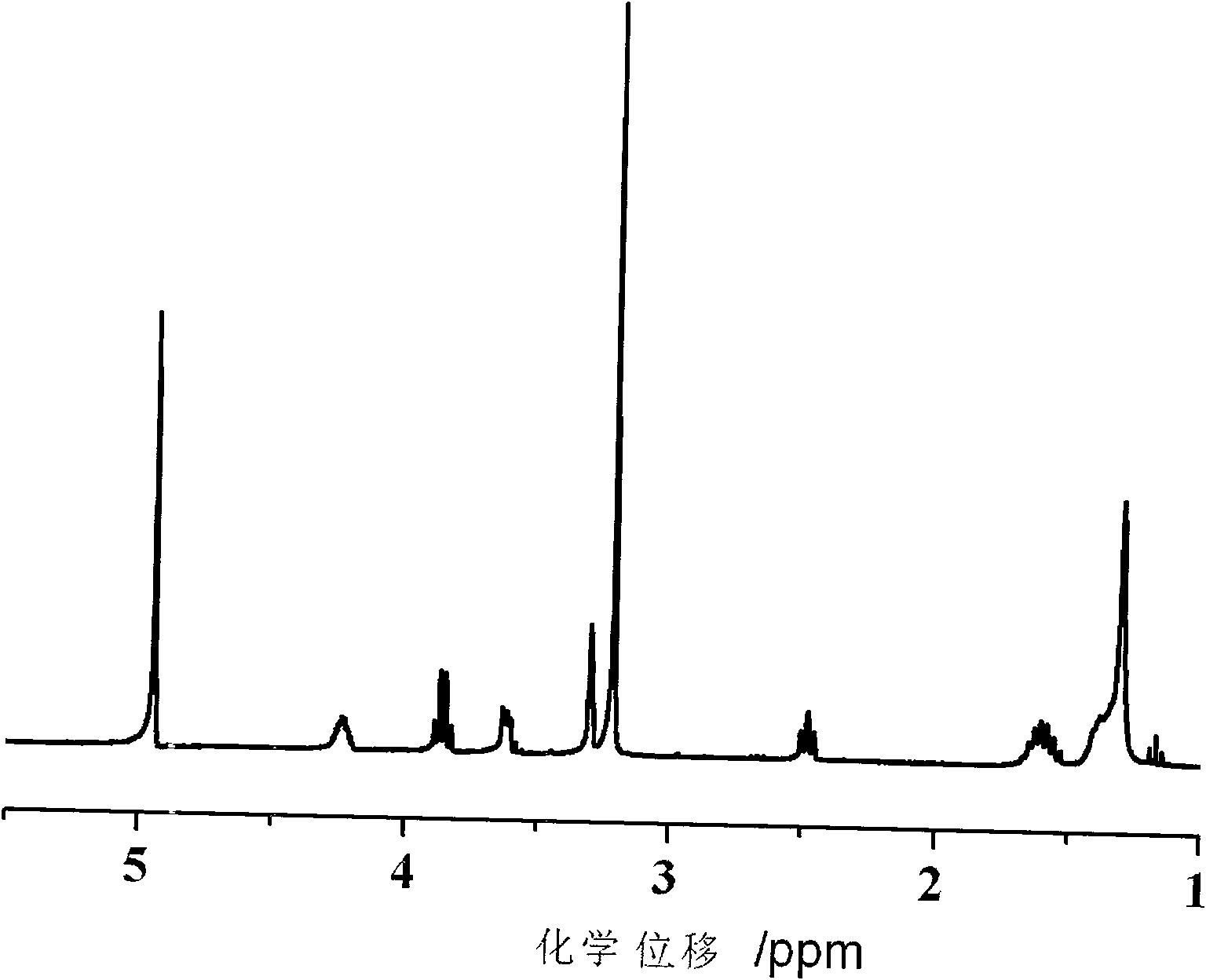Surface modifier for preparing water-solubility and high biocompatibility metal nano particles and preparation and use method thereof
A technology of metal nanoparticles and surface modifiers, applied in the field of compounds and their preparation, can solve the problems of increasing the size of nanoparticles and the influence of the bulk properties of nanoparticles, and achieves good biocompatibility, wide application range and stable chemical structure. Effect
- Summary
- Abstract
- Description
- Claims
- Application Information
AI Technical Summary
Problems solved by technology
Method used
Image
Examples
Embodiment 1
[0035] (1) Prepare the surface modifier of nanoparticles:
[0036] In a 100mL three-necked flask, add 0.025mol mercaptoundecyl alcohol and 80mL methanol, and then titrate with 1mol / L iodine in methanol solution until the solution turns light yellow, and stop the reaction with sodium bisulfate, the obtained product and sulfide in ethanol Purified by recrystallization. In a 100mL three-neck flask, add 50mL of chloroform, 0.8g of disulfide and 0.7mL of triethylamine, then slowly add 0.5mL of 2-chloro-2-oxo-1,3,2-dioxo A solution of phospholane (COP) in anhydrous THF (50 mL). After the dropwise reaction was continued for three hours, it was filtered, and the filtrate was concentrated in vacuo to obtain a white solid. The product and 2 mL of trimethylamine were dissolved in 35 mL of dichloromethane, and heated to 55 ° C to continue the reaction for 24 h. The reacted solution was cooled and filtered to obtain a white solid, which was dissolved in 5 mL of methanol, and then 0.4 g ...
Embodiment 2
[0045] (1) Surface modifier for preparing nanoparticles: except that the reaction raw material mercaptoundecanol was changed to mercaptohexanol, other experimental steps were the same as in Example 1. NMR and IR confirmed that the obtained product had the expected structure.
[0046] (2) Prepare the stable nanoparticle dispersion of surface modifier:
[0047] In a 250mL single-necked flask, add 100mL of water, after boiling, add 10mg of chloroauric acid, then add 10mg of sodium citrate, boil for 10 minutes, remove the oil bath and continue the reaction for 15 minutes to obtain gold nanoparticles stabilized by sodium citrate , TEM results showed that the size of the obtained nanoparticles was about 50nm.
[0048] In a 50mL single-necked flask, add 30mL of water, then add 8mL of the above sodium citrate stabilized gold nanoparticle solution, and then add 0.015mmol of the prepared surface modifier, and stir to make it fully mixed. The reaction was terminated after stirring for ...
Embodiment 3
[0052] (1) Surface modifier for preparing nanoparticles: except that the reaction raw material mercaptoundecyl was changed to a polyoxyethylene thiol compound with a degree of polymerization of 10 as the middle spacer, other experimental steps were the same as in Example 1. NMR and IR confirmed that the obtained product had the expected structure.
[0053] (2) prepare the stable nanoparticle dispersion of surface modifier: same as embodiment 1
[0054] (3) Hemocompatibility evaluation: recalcification time (PRT) and prothrombin time (PT) assay experimental procedure is the same as embodiment 1
[0055] The results of PRT and PT showed that the prepared nanoparticle dispersion had good blood compatibility.
PUM
| Property | Measurement | Unit |
|---|---|---|
| size | aaaaa | aaaaa |
| size | aaaaa | aaaaa |
| size | aaaaa | aaaaa |
Abstract
Description
Claims
Application Information
 Login to View More
Login to View More - R&D
- Intellectual Property
- Life Sciences
- Materials
- Tech Scout
- Unparalleled Data Quality
- Higher Quality Content
- 60% Fewer Hallucinations
Browse by: Latest US Patents, China's latest patents, Technical Efficacy Thesaurus, Application Domain, Technology Topic, Popular Technical Reports.
© 2025 PatSnap. All rights reserved.Legal|Privacy policy|Modern Slavery Act Transparency Statement|Sitemap|About US| Contact US: help@patsnap.com



